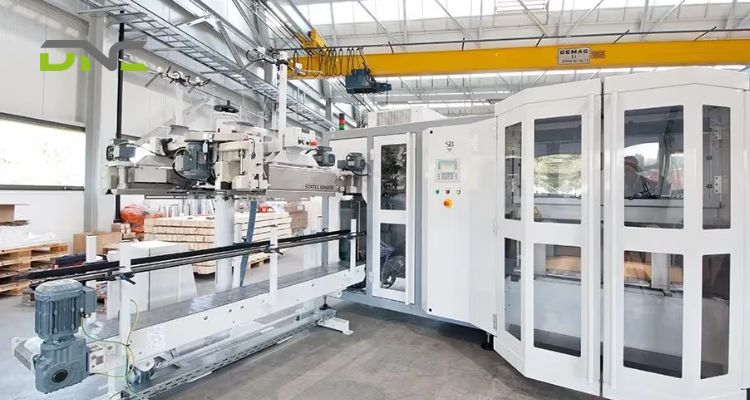Automatic Bagging and Sealing Machine
Automatic bagging and sealing machines combine filling, weighing, sealing, and labeling functions into a single streamlined process. Designed to eliminate manual handling, these systems deliver consistent packaging quality while improving production efficiency. They ensure fast, accurate, and hygienic operations, making them essential for industries such as food processing, pharmaceuticals, and manufacturing.
By automating end-of-line packaging, businesses can reduce labor costs, minimize human error, and maintain product integrity. Whether used for powders, liquids, or granular materials, automatic bagging and sealing machines provide a reliable, scalable solution for modern, high-volume production environments.
How the Automatic Bagging and Sealing Machine Works
A complete bagging and sealing cycle typically follows these steps:
- Product Feeding: The product moves from a hopper or conveyor into the filler through controlled flow mechanisms.
- Weighing and Dispensing: Sensors measure the exact product amount before releasing it into each bag.
- Bag Forming and Filling: Roll film or pre-made pouches are shaped and filled simultaneously, ensuring minimal waste.
- Sealing and Discharge: Bags are sealed using heat or ultrasonic sealing, then transferred to the discharge conveyor for inspection or palletizing.
Depending on product type, manufacturers may choose Vertical Form-Fill-Seal (VFFS) for granules or Horizontal Form-Fill-Seal (HFFS) for solid products.

How the Automatic Bagging and Sealing Machine Works
Definition and Core Functionality
Bagging and sealing machines automate the packaging process through a synchronized system of conveyors, fillers, and sealers.
- Automated Filling and Weighing: Products are dispensed into bags through auger or volumetric fillers, supported by digital load cells for accurate weighing.
- Bag Forming and Loading: Using pre-made bags or roll film, the machine forms the pouch, opens it, and positions it for filling automatically.
- Sealing and Labeling: Heat sealers or ultrasonic sealers close the bag securely. Labeling modules apply batch codes or brand labels precisely.
These functions are managed by PLC-based control systems and HMI interfaces, ensuring seamless synchronization and consistent output.
Types of Automatic Bagging and Sealing Machines
Different products require specific packaging systems. Understanding machine types helps manufacturers select the best fit for their operations.
Vertical Form Fill Seal (VFFS) Machines
Ideal for powders, granules, and snacks. VFFS machines form bags vertically from roll film, fill them from the top, and seal at the bottom.
Continuous motion and servo-driven VFFS models offer exceptional speed for high-volume operations such as coffee or rice packaging.
Horizontal Form Fill Seal (HFFS) Machines
Designed for solid or irregular-shaped products. Products like biscuits, frozen food, or medical devices move horizontally through the film during sealing. These flow-wrap systems are valued for product protection and precise film control.
Fully Automated Bagging Lines
Comprehensive, integrated packaging solutions. These systems combine bagging machines with conveyors, labelers, check weighers, palletizers, and vision inspection systems. Integrated lines offer unmatched consistency, from packaging to palletizing, and enable complete end-of-line automation.
Key Benefits of Automatic Bagging and Sealing Systems
Increased Productivity and Speed
Automatic bagging and sealing machines operate continuously with minimal human input. By replacing manual tasks such as weighing, filling, and sealing, manufacturers can significantly shorten cycle times and increase output. Servo-driven motors and PLC synchronization enable high-speed packaging without compromising accuracy, making these systems ideal for large-scale F&B and chemical production lines.
Consistent Quality and Sealing Accuracy
Automation ensures uniform filling volumes, sealing strength, and labeling position on every package. This consistency not only improves product appearance but also reduces customer complaints and returns. Heat and ultrasonic sealers deliver precise sealing temperature control, ensuring no leaks or weak seals across shifts.
Cost Efficiency and Labor Savings
With ongoing labor shortages in Malaysia’s manufacturing sector, automated systems reduce dependency on manual workers while improving line uptime. Over time, manufacturers benefit from reduced rework, minimal packaging material waste, and faster ROI — typically within 12–24 months after installation.
Enhanced Hygiene and Product Safety
Automated sealing eliminates direct contact between operators and products, minimizing contamination risks. Machines built from stainless steel comply with GMP, HACCP, and ISO 22000 standards, ensuring clean and controlled packaging environments for food, pharmaceuticals, and chemicals.
Improved Data Monitoring and Traceability
Advanced models integrate PLC, HMI, and IIoT connectivity, allowing real-time monitoring of temperature, production speed, and error logs. This helps maintenance teams predict issues early and ensures full traceability of every production batch.
Flexible Packaging Capability
Automatic systems can handle multiple bag types — from pre-made pouches to roll film — and various product forms such as powders, liquids, and granules. With quick changeovers and programmable settings, one line can serve several SKUs, supporting diversified production for FMCG and export markets.

Types of Automatic Bagging and Sealing Machines
Why Choose DNC Automation as Your Automatic Bagging and Sealing Machine?
With a decade of experience in end-of-line automation, DNC Automation stands out as one of Malaysia’s leading integrators for cobot palletizing solutions.
- Proven expertise: 10+ years of success in factory automation, robotics, and material handling systems.
- Turnkey approach: From concept design to simulation, installation, and after-sales support – DNC delivers complete end-of-line automation packages.
- Integration excellence: Seamless connection with conveyors, AGVs, vision systems, and WMS platforms for a unified workflow.
- Local engineering support: Dedicated teams across Malaysia ensure fast response, maintenance, and on-site assistance.
- Industry versatility: Trusted by clients in food processing, FMCG, pharmaceuticals, and electronics manufacturing.
- 2 views
- 0 Comment




Recent Comments